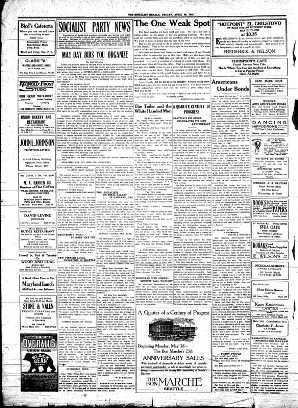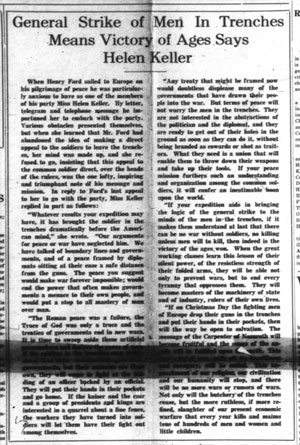Socialist Herald /
The Herald
| Report by Kaira Veckaktins Abstract: The Socialist Herald/The Herald is in the middle of a string of Socialist newspapers based in Seattle in the first two decades of the 20th century. It followed the Socialist Voice and preceded the Socialist World . In early 1916 the paper turned away from the Socialist Party and affiliated with the Nonpartisan League of Washington. Dates: April 30, 1915 - April 28, 1916: v. 3-4, no. 121-173. The newspaper may have begun two years earlier. Circulation: As claimed by The Herald, it was "Owned by Hundreds, Read by Thousands". Publishing Organization: Socialist Publishing Association, Inc. is listed as the publisher until the paper begins supporting the Nonpartisan League in February 1916. Editor: O.L. Anderson Political Affiliation: Socialist Party of Washington (1915), Nonpartisan League of Washington (1916) Business Address:1801 6th Ave., Seattle, (April 1915 – September 1915); Herald Bldg., 5th & Westlake, Seattle, Washington (September 1915 – April 1916) Collection:
University of Washington Library, Microfilm [A7146].
Status: Incomplete: The collection begins April 30, 1915 (as The
Socialist Herald) and continues June 11, 1915 - April 28, 1916 (as The
Herald). The newspaper was published weekly on Fridays but there are only 33
editions available in this collection with the majority missing from the first
three months.
The Socialist Herald (April 30, 1915 - April 28, 1916) began as a Socialist paper "Proclaiming the Co-operative Commonwealth and the Steps That Lead the Way" in Seattle, Washington. In early 1916 this paper converts to a Nonpartisan League paper and claimed to be the "Official Organ of the Nonpartisan League of Washington". It has earlier renamed itself The Herald. Electoral politics dominate the newspaper. The majority of the information in The Socialist Herald promotes candidates from the Socialist Party and later the Nonpartisan League and also informed readers of local, national and international news concerning labor and politics. Other important topics discussed in this paper are World War I, schools, and employment issues. Layout/Features Throughout 1915 this paper has a fairly consistent layout. It averages about four pages long and consists primarily of news, Socialist meetings/events, brief editorials and ads. One regular article is "Socialist Party News" which invites local Socialist groups, often the City Central Committee, to promote their events. Another column titled "Progress" is a weekly request written by the business manager for The Herald, Joseph G. Golden, asking for funding and/or help with the publication and distribution of the newspaper. This implies that the survival of this newspaper relied heavily upon the support from it’s readers and The Socialist Party of Washington. The editorials are short but are filled with persuasive arguments in favor of Socialist positions. In 1916 The Herald shifts gears and modifies its format. Along with changing it’s motto and political affiliation, it also practically doubles in length, now averaging 6-8 pages per issue. However, this new size doesn’t last long as the paper returns to the original four pages in length in March 1916. The headings are much bolder and more intriguing. A large percentage of the paper is devoted to politics as 1916 was an election year. "Socialist Party News" was replaced with the column titled "East Side News and Views" which was written by the Spokane organizer of the Nonpartisan League, Will Everett. More pictures are included in the paper in 1916, especially those of the supported candidates, and also there are a few more political cartoons. Another major change is the greater inclusion of commentary. There is at least an entire page in every issue dedicated exclusively to editorials and even the articles in the rest of the paper seem to be much more opinionated. The advertisements in The Herald remain virtually the same throughout the entire collection. They run along both sides of every page in the newspaper except the front page. They are usually quite small and simplistic. However, the Bon Marché is one of the few businesses that used significantly larger ads in this newspaper, which made them stand out among the others. Many of the ads promote stores associated with the unions including Union Made Overalls, union bakeries, and union barbershops. Also common are ads that solicit business for individuals such as attorneys and medical professionals. In addition, there are many advertisements for restaurants most of which are cafeteria or home-cooking style. War With war raging in Europe but not yet touching the United States, The Herald expresses strong antiwar views. The paper often comments on the unnecessary deaths caused by war, the Capitalist gain from war, and the extreme amounts of money spent by the government to support war efforts. The July 2, 1915 edition includes an article titled, "War is Cannibalism" which describes the gruesome deaths of soldiers at war. Another article, "You Workers Must End War or War Will End You" (September 3, 1915), explains how the government forces the working class to fight and die in the war often against their will. The Herald also uses facts and figures to back up many of their articles which helps support the idea of this paper as a legitimate news source even while simultaneously promoting their beliefs. For example, the top story in the October 15, 1915 edition provides numbers for the amount of the war loan to date and gives alternatives for how the money could have been spent to benefit the United States and it’s people on things such as education and other necessities. Education Education is an important issue discussed a great deal in The Herald. For instance, the newspaper reports on the Socialist Party and organized labor’s plan for a School Board election campaign (October 1, 1915) and follows over the next few months with articles supporting labor's candidates, Oscar H. McGill for School Director and A.G. Dentler for Port Commissioner of the North District. Just before election day The Herald attempts to distribute a copy to every voter in the city with an added focus on reaching public school teachers. This was part of a broader Herald campaign to democratize the schools. An interesting article in the December 24, 1915 issue titled, "A Day in a School Where Schooling is a Pleasure" explains the ideal Socialist education as "work made into play", parental involvement, and specialists as educators all being available without extravagant spending. Politics/Elections The Herald was definitely used to promote the political views and candidates supported by their staff. Along with endorsing school officials The Herald also put much effort into informing and persuading readers on political affairs. For example, when The Herald became a Nonpartisan League paper, every issue was filled with articles raving about this new affiliation and it’s growing power. This sudden change in political affiliation comes as quite a surprise to the reader, which may only be a result of the incompleteness of this collection. Included in the papers are a "Document Governing Nonpartisan League" (March 3, 1916), "Constitution of the Nonpartisan League" (March 10, 1916), and applications to become a member of the Washington State Nonpartisan League. The Herald backed it’s political candidates by dedicating large amounts of space for articles and pictures and also by including negative pieces about the opponents. Many articles were written encouraging people to register and vote. Labor The Herald is a pro-union newspaper that includes a great deal of information on the labor force and strikes during this time period. Much is written concerning unemployment including the article, "Seattle’s Unemployment Problem Now Up to the People for Settlement" (August 20, 1915). Additionally, The Herald makes it a point to report on strikes occurring both nationally and internationally. Working conditions for women and children are also addressed. Events These selected events are mentioned in great detail: • The First Western Washington Socialist Encampment (July 2, 1915) • The Seamen’s Laws (September 17, 1915, September 24, 1915) • Anacortes Municipal Ticket (December 3, 1915 - Anacortes Edition) • Nonpartisan League of North Dakota (January 28, 1916) People/Groups Much attention/support is given to these people or groups (not previously mentioned): • Cornelius Lehane, Irish Labor Party (August 27, 1915) • James Larkin, Irish labor orator (September 3, 1915) • The Finnish Federation (September 24, 1915, October 1, 1915, October 8, 1915) • Mme. Sorgue, female Socialist leader in London (October 1, 1915) • Adolph Germer, executive committee of Western Federation of Miners (October 15, 1915, October 22, 1915) • Helen Keller (December 17, 1915, January 21, 1916) • Edwin J. Brown (January 28, 1916, February 18, 1916) • Otto A. Case, secretary of Nonpartisan League (March 24, 1916) • Governor Johnson (April 14, 1916, April 28, 1916)
Contents of The Socialist Herald/The Herald microfilm: 1915 April 30 June 11 July 2 August 20, 27 September 3, 10, 17, 24 October 1, 8, 15, 22, 29 November 5, 19, 26 December 3, 17, 24 1916 January 23, 28 February 4, 18 March 3, 10, 17, 24, 31 April 7, 14, 21, 28
|
Click to enlarge War Like many progressives and leftists on the eve of America's entry into World War I, the editors of The Socialist Herald took a hard lined anti-war stance. War, the paper argued, was not in workers' interests, and they should have no part in it. Politics The paper vehemently supported Socialist political candidates. On July 12, 1915, the paper also advertised for the first annual Socialist Encampment, where party members would meet for three days, socialize, and discuss their political plans.
The paper frequently featured articles written by, or reprints of speeches given by famous Socialists. Here, a speech given by Helen Keller arguing against war was reprinted.
|
|
|
|





.jpg)


--July%2012,%201915--p.1%20300w.jpg)
